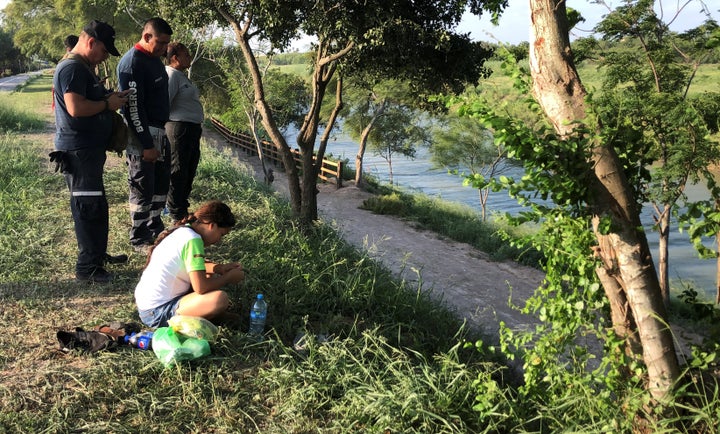
If you logged onto platforms like Twitter or Facebook this week, you may have seen a photograph liberally scattered across social media, showing the corpses of 26-year-old Óscar Alberto Martínez Ramírez, and his 23-month-old daughter, Valeria, floating face down in a river.
Media outlets used words like “shocking” or “grim reality” to describe the photograph, frequently adding it as thumbnails to their articles, treating it as a spectacle. The family had drowned in an attempt to cross the border into Trump’s anti-Latino America, and the image showed one of the devastating tragedies a human being can go through. Horrified at what I saw, and what was happening at the border crossing, I also found myself questioning why the media treat the corpses of black and brown people so unceremoniously, exercising a sort of dehumanising, macabre voyeurism.
This was illustrated in the case of Alan Kurdi, the Syrian-Kurdish toddler that washed up on a European beach. After being misnamed by the press, his photograph, like Óscar and Valeria’s, was splashed across the media. The world appeared outraged – for a moment; some public figures even made allegations that the photo was “staged”. It was not long before the image faded into the media ether, just another “shocking” photo of a brown corpse in an endless stream of breaking news. And, all the while, it is hard even contemplate a scenario where the British press would dare publish a photograph of the corpse of a drowned white, British baby washed up on a beach.
In 2018, a photograph was published of the bodies of 29 black migrants piled up on a boat on the Mediterranean. The caption did not list their names, where they were from, or who they were. Instead, the caption reads “the rescuers counted 29 dead bodies – 10 men and 19 women, all between 20 and 30 years old”. There was no mention of whether they received permission from the victims’ families to publish this graphic and intimate photograph. Completely robbed of their human dignity, these men and women are presented stacked on top of each other – a pile of nameless corpses.
On television, we are bombarded with adverts and images of black and brown, emaciated and dying children from around the world. These are often inserted into television schedules and, while on some level the intention is well meaning to encourage charity, these have become a mere footnote in the television experience. Most viewers are not moved anymore but, at best, may have a fleeting moment of pity – before they continue with their dinner, or catch up with the latest episode of Corrie. Seeing dying babies and children should not be such easy and casual viewing, but the persistent lack of humanity and dignity afforded to these victims has created an environment of apathy.
Elsewhere, the wanton broadcasting of images and videos of unarmed black people being killed by police, most frequently in the US, demonstrates another facet of the issue. Indeed, it’s impossible to count the amount of times articles and videos appear online graphically showing the last moments black people as they are murdered by police. Not only are they provided with no human dignity, reduced to another spectacle for media consumers to see, it can have a traumatising effect on black communities. This is also part of the broader issue of how black people are treated by the media, here robbed of human dignity, and elsewhere consistently criminalised in the press.
Of course, there is the argument that showing these horrific realities can mobilise the public and create change. Indeed, in 1972 the photograph of Phan Thi Kim Phuc running naked in the aftermath of a napalm bomb during the Vietnam War sent shockwaves across the world. However, the contemporary world is saturated by a constant stream of media and information. Images, which once may have had a substantial impact, no longer garner tangible change. Despite the images like Alan Kurdi’s, that of the 29 migrants, and Óscar and Valeria’s, refugee men, women, and children are still dying, and the refugee crisis and xenophobia rages on. Despite years of countless videos of black people being killed by police surfacing, violent racism towards black people is still rising.
The casual broadcasting of graphic and distressing images of black and brown bodies so liberally by press, coupled failing to afford appropriate context or human dignity, only serves to exacerbate the deficit of compassion and humanity extended to these groups. If the motive of covering tragedies like these sincerely is to create change, then there must be a radical shift in approach. Óscar, Valeria, Alan, the 29 refugees, unarmed black people, and others subjected to the same posthumous treatment must be humanised, and their lives not reduced to a “shocking” photo opportunity. It is a damning insight into society if the only way news outlets feel they can invoke public sympathy for these people is by sharing images of their corpses. Likewise, it is a damning insight into the media at large if there is a culture to publish dehumanising and degrading images of corpses.
Until the media, and society, treats victims like those discussed here as human beings, affording compassion and human dignity, the cycle of tragedy and chronic apathy will continue – becoming the final injustice.
